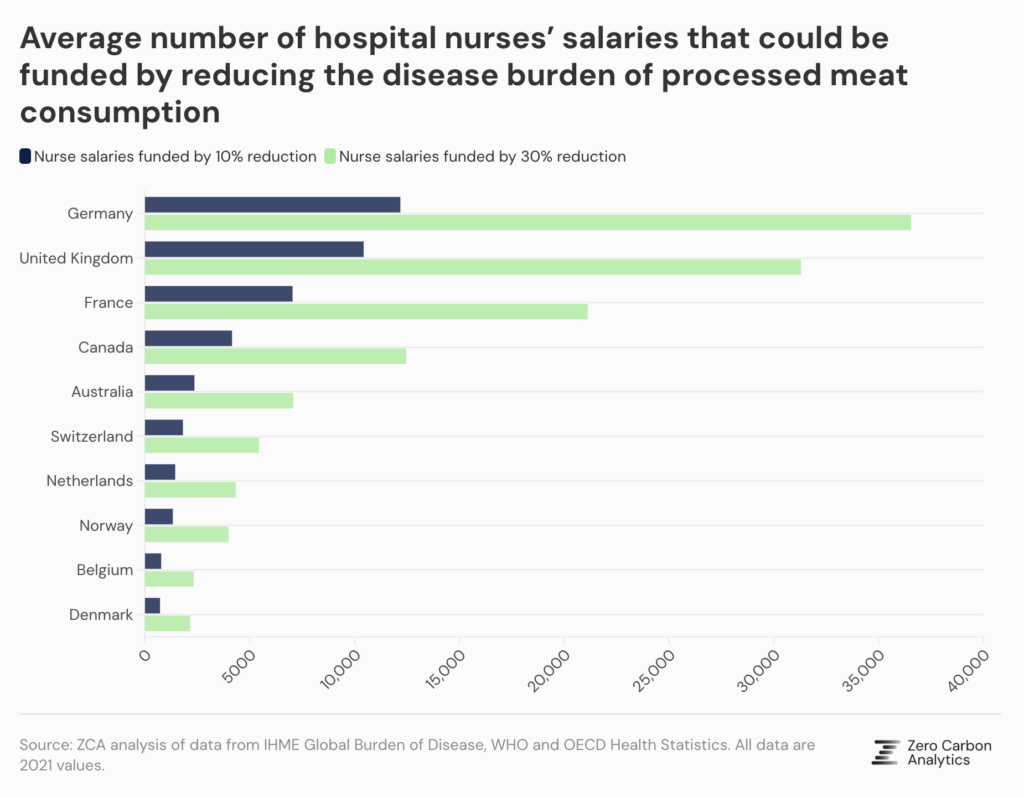
Cutting back on bacon and burgers could release the disease burden in rich countries and save their ailing healthcare systems, according to a new analysis.
A growing incidence of long-term health conditions, combined with persistent staff shortages, poor wages, and rising drug costs, has put the world’s healthcare systems on red alert.
In the UK, for example, the National Health Service has been so overstretched for years, the government has announced a 10-year plan to “reinvent” the organisation. Across the Atlantic, proposed cuts to healthcare subsidies are at the heart of the government shutdown in the US.
But a new report suggests one simple action could lighten the load on national healthcare systems: eating less meat.
Researchers at Zero Carbon Analytics have found that wealthy countries consume high amounts of red and processed meat and face a substantial disease burden as a result. But they present strong opportunities for introducing primary prevention to decrease this burden and save treatment and management costs.
Their analysis comes right around the 10-year anniversary of the WHO’s classification of processed and red meat as Class 1 and 2 carcinogens. Since then, calls from health and climate experts across the world to limit consumption of these proteins have shot up rapidly. And this new analysis adds an economic angle to that argument.
Europe is at the heart of the meat-induced health crisis

Study after study has linked red and processed meat to a range of chronic diseases, including type 2 diabetes, cardiovascular disease, and cancer. For instance, a large review this year concluded that no amount of processed meat is safe for human health. The equivalent of one hot dog increases the likelihood of colorectal cancer by 7% and ischemic heart disease by 2%.
Research also shows that chronic diseases are responsible for 74% of all deaths, but dietary change can prevent 15 million premature deaths every year. Zero Carbon Analytics further highlighted that processed meat was responsible for 295,000 deaths in 2021 alone, while red meat caused 334,000 deaths.
But in spite of these well-established health risks, meat consumption has increased by 20% between 2002 and 2022. Unsurprisingly, people in wealthier nations eat more meat per capita. That said, middle-income countries are projected to largely drive a 2% increase in global demand for meat over the next decade.
The report suggests that, in addition to the human loss caused by red and processed meat, the preventable disease burden takes a substantial financial toll on societies. Globally, the health-related costs of consuming these proteins reached $285B in 2020, based on direct medical expenses like hospital care and medications, and indirect costs like loss of productivity and informal care.
Europe, in particular, faces significant premature mortality and years of life spent with chronic, disabling conditions. The continent accounts for 14 of the top countries with the most years of life lost due to red meat consumption, led by Belarus and Bulgaria.
The premature mortality burden of processed meat in the continent – 18 of the top 20 countries on that list are located in Europe, with Lithuania, Latvia and Estonia facing the worst impacts. Non-European countries in the top 20 are the US (which has the highest incidence of non-fatal illnesses from meat consumption), Japan, South Korea and Canada.

Even a small reduction could help pay legions of healthcare workers
To pinpoint the countries where dietary changes could yield the greatest economic and health returns, the researchers calculated the average healthcare spend per year of healthy life lost to either disability or premature death from consuming red and processed meat.
Australia, New Zealand, South Korea, Singapore, and several European countries achieved better health outcomes than their peers, which the researchers said were due to systemic advantages like robust healthcare systems capable of mitigating dietary risks.
But the better-than-expected outcomes came at a significant opportunity cost – these countries may be spending heavily to manage preventable disease, rather than investing in prevention to avoid it altogether.

Zero Carbon Analytics then calculated how a reduced meat disease burden would bring potential cost savings to national healthcare systems.
Reducing the disease burden caused by processed meat by 30% could free up $21B in healthcare spending in the US, enough to cover the salaries of 247,000. Likewise, it would save $2.2B in Germany (enough to pay 36,500 nurses), $1.4B in the UK (31,000 nurses), and $970m in France (21,000 nurses).
The report noted that policy interventions are crucial to reduce the disease burden caused by eating too much red and processed meat. For instance, following the Dutch dietary guidelines could significantly cut the country’s future burden, including around 20% fewer cases of diabetes and coronary heart disease by 2050.
In fact, in the Netherlands, healthcare systems subsidise the health costs of meat overconsumption, instead of “consumers paying the true cost of their dietary choices”. If these expenses are added to meat prices, red meat would cost €7.50 more per kg, and processed meat €4.30 more – and that would roughly double if the environmental toll is also taken into account.

“These findings support the European Commission’s call for fiscal policies to tax processed meat, restrict marketing to children, and align national dietary guidelines with the Planetary Health Diet, which recommends limiting red and processed meat to no more than zero to three servings per week,” the authors write.
“Public money is being used to pay the externalised costs of processed meat giants. This is a crisis which is morally, socially and economically intolerable,” noted Dr Chris Van Tulleken, author of the book Ultra-Processed People. “The solutions are as clear as the problem, but will require immense political courage and public support to bring about.”
The post How Reducing Red & Processed Meat Can Solve the Healthcare Crisis appeared first on Green Queen.
This post was originally published on Green Queen.